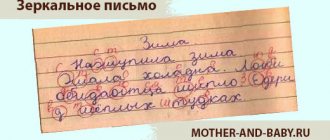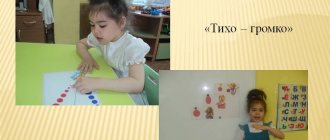The teacher again and again makes the remark that the child is inattentive and recommends writing more from dictation at home. Responsible parents try to help their student. But ridiculous mistakes are repeated again and again, and instead of success in improving written speech, the child gets tears from failures, a negative attitude towards writing, problems with the child’s self-esteem and loss of motivation for the writing process.
Most often, this problem fully manifests itself when the child enters 2nd grade. Although mistakes can be noticed already in the last quarter of the first grade. When children, having learned the basics of writing, move on to exercises that require greater writing speed.
Unfortunately, school speech therapists often do not use a neuropsychological approach to the analysis of learning difficulties at school. And they do not diagnose “dysgraphia” for such difficulties. This means that the child does not receive proper help and the problem develops into dysphoria.
And in recent years, such difficulties have become more and more common in children who generally do not have problems with the development of mental functions, in children with a high level of intelligence. For example, parents are faced with the fact that the child “cannot concentrate on completing a task,” “counts crows in class,” or “finds out words when reading.”
And instead of helping the child overcome such difficulties, teachers and speech therapists advise parents to write more, read more, educate better, and be stricter about doing homework.
What causes missing letters in a letter?
- speech therapy reason - difficulties with pronunciation and perception of certain sounds;
- poor concentration;
- undeveloped self-control skill;
- poor vocabulary;
- low performance
Speech therapy reason
If a child does not pronounce some sounds, then I, of course, highly recommend seeking help from a speech therapist. But, in addition to the exercises recommended by a specialist, parents can provide invaluable help to their child if they perform the following types of tasks in the form of a game:
- isolating the first or last sound from a word;
- the presence (is, is not) of a given sound in a word;
- determining the place of a sound (beginning, middle, end) in a word;
- inventing words with a given sound;
- inventing words with a given sound in a given place (at the beginning of the word, middle, end);
- composing chains of words, naming the word based on the last sound of the spoken word;
- transforming words by replacing, rearranging or adding new sounds (lac-bow, rose-thunderstorm, saw-linden);
- counting sounds in a word. You tell the child a word and ask him to say how many sounds it contains. And it’s better if you know the phonetic analysis of a word, then how many letters and sounds are in the word.
Poor concentration
The development of a child’s attention in preschool and primary school age needs to be constantly addressed. There are many different techniques for this:
- Invite your child to copy down non-existent words without errors;
- cross out or underline the specified letter or letters in the text (2-4);
- write small dictations where the child writes only vowels or only consonants;
- write visual dictations;
- divide written texts into separate words;
- write a given letter in block letters, etc.
You can also use various games to develop attention.
Undeveloped self-control skills
The following exercise will help you assess what needs to be developed more in your baby, attention or self-control skills.
Writing words or sentences with your eyes closed.
- Prepare a landscape sheet. Dictate 5-6 words of 4-8 letters to your child. You can dictate 3 sentences of 4-5 words each.
- Take another sheet and do the same, but this time let the child write with his eyes closed.
The writing speed will be slow. This is fine.
There is no need to evaluate the evenness of a line, the space between words, the break of a word, or the partial overlap of letters on each other. Ignore spelling errors due to ignorance of any rules.
Self-control is weak if the number of errors is greater than in similar sentences written under dictation with open eyes.
Teach your child to slowly reread what he has written each time. Read not the way the sound of this word remains in his memory, but exactly the way it is written. If this is cheating, then it is mandatory to compare the written words with the original recording.
Poor vocabulary
If a child hears a word for the first time, the likelihood of spelling it incorrectly increases several times. Therefore, tell your child as much as possible, read with him, develop the baby’s speech, his curiosity, constantly communicate with your child as much as possible.
Many children, unfortunately, entering first grade do not have basic knowledge about themselves and the world around them. And this, of course, is primarily the fault of the parents. It is more difficult for such children to study; they experience discomfort watching their more erudite classmates. I advise you to familiarize yourself with what a child should know by first grade.
Low performance
We are all different. Also, naturally, some children are diligent, and some are not at all. But you can always find a way to motivate a child, explain to him and convince him of the need for this or that action. Be sure to create a situation of success for your children. And, of course, exclude all distractions: conversations, extraneous noise, TV, etc. And we remember that the performance of a child differs from the performance of an adult. This quality develops over time.
Special exercises in the form of exciting games
help the child, and even completely solve this problem
Learning not to skip letters
You can help your child overcome difficulties in mastering competent written speech on your own. To do this, you need to play, and not write exhausting dictations.
The presented games and tasks help to set up work, activate control functions, train attention switching, and develop the functions of block III of the brain (programming, control, serial organization of movements). ⠀
- "Steep turns." Place any bulky items (stationery, cubes, etc.) in front of the child (on the floor or table). The child's task is to roll a light tennis ball around obstacles, guiding it with a stream of air. And so reach the finish line.⠀
- "Finger games" to the rhythm. The adult pronounces the words of the nursery rhymes, while showing movements with his hands, and the child repeats the movements.⠀
- "Climber". The child’s task in this game is to walk along the wall, touching with three points. That is, the initial position is the child’s back to the wall and touches it with his palms and heels. To move along the wall, you can tear off only one support from the wall and rearrange it. Start at a very slow pace. And when the child has thoroughly mastered the rules of the game, speed up the pace.
- "Conductor". Here you will need cards with hand poses. Or commands can be described in words. For example, “left up”, “right forward”, etc. At the command shown on the card, the child performs hand movements and at the same time pronounces the letters in alphabetical order. ⠀
- "Corrector". This game uses randomly printed letters as a guide. The child’s task is to quickly (as quickly as possible) find and cross out a specific letter. To make it even more challenging, ask your student to find several letters and mark them in different ways: for example, “K” - crossed out with a cross, “R” - circled, “F” - with a wavy line.
- "Grammino" This game is based on the domino principle. We divide the cards (size 10 cm * 2 cm) into two parts. On one of which write a word, omitting one letter, and on the second part write a letter, but not the one that is missing, but any letter from another word. The presenter distributes 7 cards. And one player puts any word, and the second player puts a suitable letter next to it. As we spend cards, we replenish our reserves from the general pile of words. We play until the last card. For variety, you can play another game with these cards - speed - take a card with a word and quickly take turns with your child to name the missing letter. ⠀
- "Oh and Ay" . There is no preparation required here. You need to count from 1 to 100. Only instead of numbers that are multiples of 5 we say “Oh”, and instead of numbers that are multiples of seven we say “Ay”. Fifty-seven, for example, will sound like OH-AY.
- "Scanner". We write a word of 5 or 7 letters on a piece of paper. Let's say the word "spoon". And ask to name the letter in the middle of the word (spoon). Then name the first letter to the right of “F”, the first on the left, the second on the right, the second on the left. ⠀
- "Rhythmic Reading" We ask the child to read the text. You need to read syllable by syllable, since the words are written (so-lo-ma, vo-ro-bey), at this time the adult taps out a rhythm that corresponds to the syllabic structure of the words. At the second stage, the child reads the words himself and taps the rhythm with a pencil on the table or simply with his palms. After this, the child copies (or takes dictation), and the adult taps out the rhythm. Such exercises are very effective in correcting any writing problems. ⠀
- "Letter of Instructions." In this exercise, you need to draw a pattern (on each line) in a notebook with an oblique, straight line, which will consist of loops and sticks. When performing a task, it is important to pronounce the direction of movement of the hand: stick, hook, up, down, loop.
- Schulte tables. For second-graders, it is enough to master tables up to 25. By the way, there are now applications for smartphones with Schulte tables. This is very convenient. Each time the application produces a new composition of numbers, and when completing a task, the result is immediately visible in the form of completion time.
- "Geometric beads" Prepare geometric shapes from colored paper. Place the lubu in front of the child. Sequence of figures (5-7 elements). Ask to remember (no more than 1 minute), then “break” the row and ask the child to repeat the pattern.
These tasks do not have to be completed every day. But by training your child in this playful way, performing 4-5 exercises daily, you will definitely get noticeable results in just two weeks. And help your student believe in himself!
Why does dysgraphia occur in adults?
The impetus for the development of written language disorders in adults can be many external and internal factors. Having a negative impact on the functioning of brain structures, such factors cause dysgraphia and other mental dysfunctions.
Among the main reasons causing problems with correct writing in adults, experts identify:
- head injuries;
- neurosurgical operations;
- proliferation of brain tumors;
- infectious brain damage (meningococcal infections);
- inflammatory processes affecting the brain (meningitis);
- strokes;
- trauma during childbirth;
- appropriate social conditions;
- insufficient blood oxygen saturation (asphyxia).
Why does a child write “like a chicken paw”?
Many parents attribute poor handwriting to laziness, character traits, and even the gender of the child. Like, boys are not inclined to diligently write letters. This opinion is wrong and even dangerous. After all, how do you fight laziness? That's right, double the load. The student is forced to write letters over and over again, thereby causing a persistent dislike for writing and school in general.
Remember - every student would like to write beautifully, receive good retribution and listen to praise. No one decides to write like a chicken paw. Some people get beautiful letters by themselves, while others have to try hard, and still the handwriting turns out to be imperfect. The reasons need to be looked deeper.
Writing skills are based on three pillars:
- Functional readiness for writing. Mental functions must be sufficiently developed for the child to be able to write.
- Social and pedagogical aspect. Preschool education, family attitudes toward reading, and the nature of communication with adults, including teachers, play a significant role.
- Level of motivation. To write beautifully, a child must want to learn.
From these foundations a student’s literacy is formed. If one point is violated, certain problems will arise in school. Poor handwriting is a signal that your child needs help.
Common Causes
It’s hard to believe, but experts recently found that first-graders in writing lessons experience the same loads as astronauts during launch. What seems simple to an adult is incredibly difficult for a child.
The situation is aggravated if the following factors occur:
- Inconvenient workplace. If a student sits or holds the pen incorrectly, he gets tired quickly. This is certainly reflected in the handwriting. Try writing a sentence yourself, taking an awkward position. What if the notebook constantly slips and your fingers slip off the pen?
- Insufficient level of development of fine motor skills. Writing letters requires precise movements of the fingers and hand. If a child’s motor skills are poorly developed, then writing will be difficult for him.
- Insufficient level of spatial perception. To write beautiful letters, you need to have a good grasp of the sheet of paper. At 6–7 years old, children may not yet be able to correlate letters with squares, determine right and left, or calculate indentations.
- Severe shock (parental divorce, death of a loved one, difficult adaptation to school) or illness. If, during the period of active learning to write, a child experienced severe stress or was seriously ill, it is not surprising that he will lag behind his peers. Handwriting may even deteriorate. Most likely, there will be a “rollback” in all subjects and areas of the child’s activity.
Causes of poor handwriting from a neuropsychological point of view
Neuropsychology helps understand the connection between a child's behavior and brain functioning. Behind bad handwriting is almost always the immaturity of certain parts of it.
- If after a short time a student begins to yawn, spin around in his chair, or drop his pen, his first block is not sufficiently developed. It is responsible for activating the brain. To “turn on”, the child needs more oxygen. To do this, increase blood flow with the help of special exercises and breathing exercises.
- When letters are written in mirrors, confusion, or incorrect placement of text in the notebook, the second block turns out to be immature. It includes visual, auditory and skin-kinetic analysis, as well as phonemic hearing, spatial orientation and visual perception.
- If a child knows the rules, but still writes with errors and does not comply with the norms of behavior, then the third block is underdeveloped. This is a programming and control unit.
Undeveloped blocks can be “launched” with the help of special games and exercises, breathing exercises, and outdoor activities. Adequate development of the child will help overcome difficulties. If the problem is serious, you can connect a neuropsychologist. Using special techniques, a specialist can redistribute the functions of brain structures, even if they are damaged.
Poor handwriting in a child in 2nd grade
In first grade, bad handwriting is not uncommon. Children are just learning spelling and practicing how to write letters beautifully. Handwriting improves throughout the school year. But if the problem remains relevant in 2nd grade, this is a serious reason to think about it. Possible causes of poor handwriting include dysgraphia and motor disinhibition syndrome.
Dysgraphia
Dysgraphia is a neurological disorder that results in severe difficulties in motor and sensorimotor functions. Dysgraphia literally translates as “difficulty writing.”
Characteristic symptoms:
- bad handwriting;
- problems with spelling;
- The child has difficulty expressing thoughts on paper.
There are 3 main types of dysgraphia:
- Dyslexia. Manifests itself in illegible writing of letters and errors in pronunciation. The child speaks and writes incorrectly. But at the same time he is able to rewrite the text without errors.
- Motor dysfunction, motor disinhibition. Due to problems with motor skills, children write and rewrite letters and words illegibly.
- Spatial dysfunction. Children are poorly oriented in space, write and rewrite illegibly. They may start writing in the middle of the sheet, go beyond the margins, and move the word to the next page.
A speech therapist and psychoneurologist can make an appropriate diagnosis after 7–8 full years. If dysgraphia is suspected, hearing and vision impairments are excluded.
conclusions
Normally, mirror writing of numbers and letters should be taught in elementary school. If this does not happen, the violation becomes persistent. A fixed skill distorts thinking, which negatively affects the mental abilities and academic performance of schoolchildren. Doctors and parents themselves can help children. Having noticed deviations, begin corrective exercises. If you can't cope, contact a specialist. The main thing is not to leave mistakes in writing letters and numbers unattended and hope that everything will improve with age.
Previous post Why does a 4-month-old baby hold his head poorly?
Next entry How to wrap a child in a blanket without a belt
When working with your child, remember a few basic rules:
- Throughout special classes, the child needs a favorable regime. After numerous twos and threes, unpleasant conversations at home, he should feel at least a little success.
- Avoid testing your child's reading speed. It must be said that these checks have long been causing fair criticism from psychologists and defectologists. It’s also good if the teacher, understanding the stress the child experiences during this test, conducts it without emphasis, hidden. But it also happens that they create a complete exam situation, call the child alone, put a clock in front of him, and even check it not with his own teacher, but with the head teacher. Perhaps for a student without problems all this does not matter, but in our patients neurosis can develop. Therefore, if you really need to test your reading speed, do it as gently as possible.
- Remember that you cannot give exercises in which the text is written with errors (subject to correction).
- The “read and write more” approach will not bring success. Better less, but better quality. Do not read long texts or write long dictations with your child. In the first stages there should be more work with oral speech: exercises to develop phonemic perception, sound analysis of words. Numerous mistakes that a child with dysgraphia will inevitably make in a long dictation will only be recorded in his memory as a negative experience.
- Do not praise too much for small successes; it is better not to scold or be upset when the child does not succeed. It is very important not to show your child your emotional involvement: not to get angry, not irritated, and not to be overly happy. A harmonious state of calm and confidence in success is better - it will be much more conducive to sustainable good results.
Detection of dysgraphia in adults
Treatment of writing disorders in adults, as well as in children, begins with a specialist studying written work done using special techniques. First of all, the speech therapist needs to determine whether writing defects are a manifestation of dysgraphia, or are the result of a person’s illiteracy. The subject performs a number of written tasks, including:
- copying text material (printed and handwritten);
- writing a dictation;
- writing descriptions for pictures;
- reading a whole text, as well as individual words and separate syllables.
During the diagnosis, the state of oral speech is also studied, which includes:
- assessment of the correct pronunciation of sounds;
- vocabulary learning;
- analysis of skills to identify sounds by ear.
After conducting the necessary tests, the speech therapist analyzes the errors, identifying among them those that are typical for certain types of dysgraphia. Next, a speech therapy report is drawn up. If the diagnosis is confirmed, further correction of the defect is required.
Handwriting correction.
The fact is that for a child with dysgraphia, handwriting causes a certain difficulty. Typically, such children write either very small or extremely large. Sloppy handwriting is not a negative thing, and you shouldn’t scold a child for it.
It will take about three weeks to teach a student to write correctly. First, you need to purchase a squared notebook and ask to reproduce the text on paper. The letter should not go beyond the cell - the main rule. You need to monitor this and support the child in every possible way.
You cannot overload children; a few correctly written lines a day are an excellent result. Even if parents are tired of working with their child, it is strictly forbidden to show it, much less raise their tone. It is recommended to use pens with a ribbed surface as writing instruments, as well as pencils in the shape of a triangle.
At home, you can play with your child by giving him a pen and ink. Then he will try to write correctly so as not to spoil the game.







